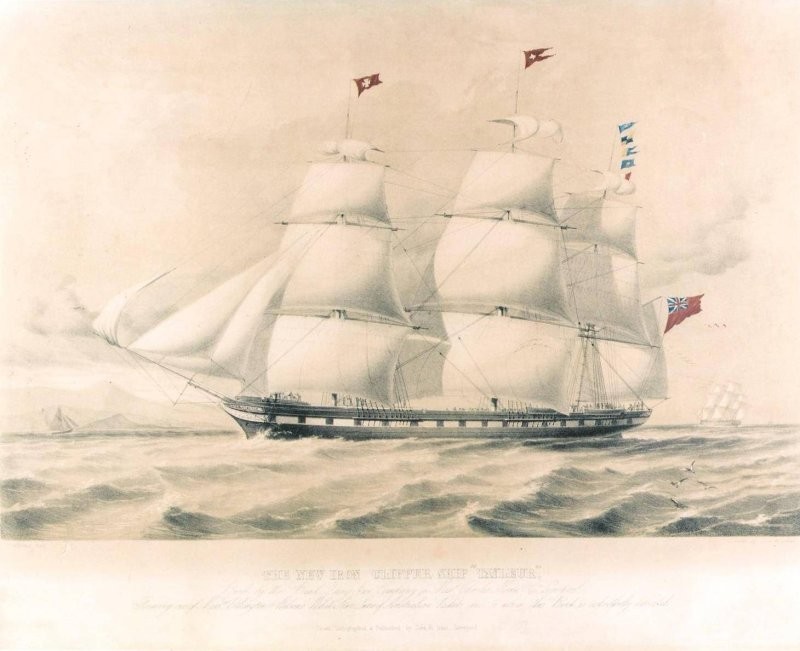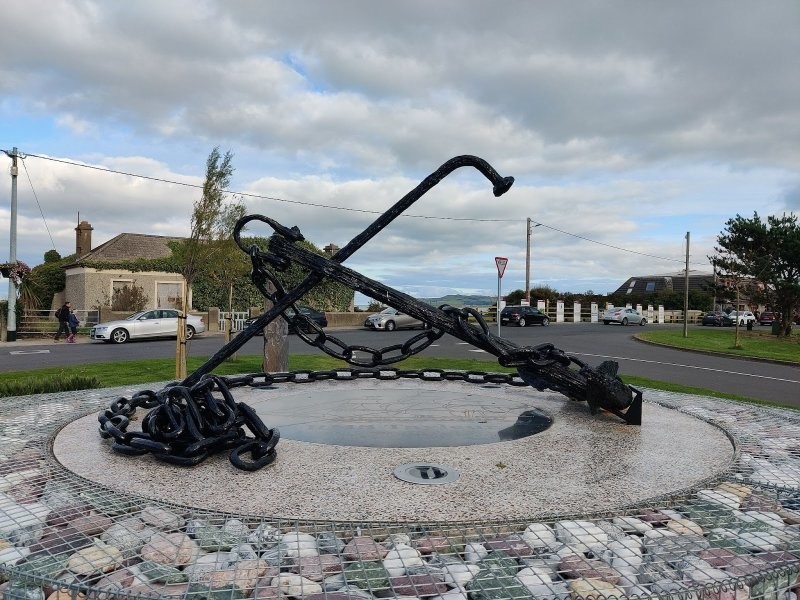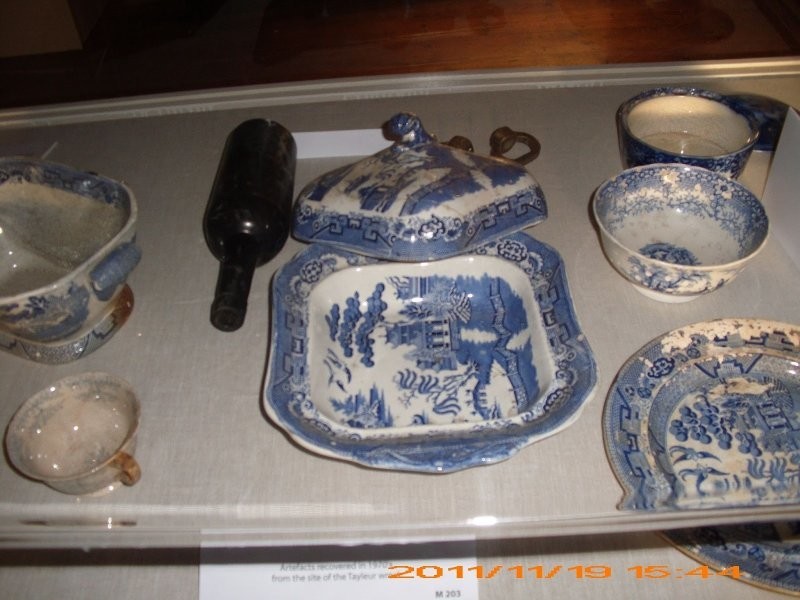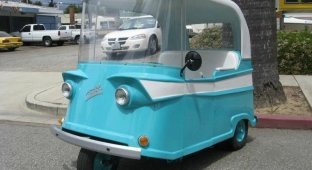The forerunner of the Titanic. RMS Tayleur disaster (4 photos)
The desire to create the ideal ship is inherent in everyone who is involved in shipbuilding to one degree or another. Speed, power, size, unsinkability - designers are always trying to improve these qualities in their projects. And when scientific and technological progress makes it possible to get one step closer to their cherished goal, they do not miss their chance. 
RMS Taylor
The introduction of metals and steam engines in the navy became just such a factor. But no matter how perfect the ship is, it is still controlled by people. Often their qualifications are not enough to understand all the designers’ decisions and provide the new vessel with the level of reliability that was built into it. One of these cases will be discussed below.
The sailing clipper RMS Tayleur was built in 1853 at the ironworks of Charles Tyler, after whom she took her name. The construction of the metal ship, 70 meters long and 12 meters wide, took just over six months. RMS Tayleur had three decks, displaced 1,750 tons and could carry over 4,000 tons of cargo. Its very construction initially envisaged the use of the vessel on one of the most popular routes in those years - from Liverpool in England to the Australian city of Melbourne. The route became popular because of the gold found in Australia at that time and, as a result, the gold rush that broke out there. A large number of different kinds of adventurers from the Old World poured into the Australian continent.
It is worth noting that the company that chartered the RMS Tayleur for this route was the White Star Line, which later became infamous throughout the world thanks to the well-known Titanic liner.
However, even in those days this company was one of the largest in the field of cargo and passenger transportation. The excitement that flared up around the found gold could not pass her by. Already on January 19, 1854, RMS Tayleur set off for the first time. There were 652 passengers and 71 crew members on board. RMS Tayleur had an iron hull and was much more resistant to various sea hazards than its wooden counterparts. Nevertheless, the new and not yet sufficiently developed material led to one of a series of tragic accidents.
When preparing the ship for sailing, a magnetic compass was installed on it. But the designers did not take into account that the ship’s hull itself has its own magnetic field, which is why the compass could not point exactly to the north pole. After leaving Liverpool, RMS Tayleur, according to the captain and the entire crew, sailed south for two days, crossing the Irish Sea. In fact, the clipper was moving almost due west, towards the coast of Ireland. As a result, on January 21, during a strong storm, the ship found itself not far from Lambay Island. They managed to notice the land, and the clipper changed course. However, at this moment another major drawback of the new ship was revealed. The RMS Tayleur had a steering wheel that was not large enough for its size, which affected maneuverability. Moreover, the ship's rigging turned out to be poorly covered. As a result, the maneuver did not work out. Even after releasing both anchors, the ship was still unable to avoid colliding with the rocks off the eastern part of the island, about five miles from Dublin Bay. 
Emblem of the White Star Line, the company that owned the RMS Tayleur and later the Titanic
In the process of the beginning of the struggle for survivability and counteracting panic, several more unpleasant moments were revealed. Firstly, 29-year-old John Noble, who did not have much experience in managing such ships, was appointed to the position of captain. More than half of the crew were people hired as sailors for free passage to the coveted continent and gold. They had almost no idea about maritime affairs. Ten people on the team didn't speak English at all. Thus, one can imagine the chaos and panic that began on board after the crash. The first boat launched was immediately smashed against the rocks, after which no new attempts were made. Fortunately, the storm has calmed down a bit. It turned out that the shore was literally a stone's throw away. The part of the team that got down to business cut down the mast and managed to throw it from the ship to land. After which several people crossed it and managed to pull ropes, along which many passengers and sailors managed to get to the shore.
Meanwhile, the weather began to worsen. The ship began to be torn off the rocks and carried to the depths. The last person to leave the ship by this time, having already jumped into the water, was the captain, who remained on board until the end. Luckily for him, he managed to swim out and was saved. The ship was carried further from the shore, where it lay on the bottom so that only the tops of the remaining masts stuck out on the surface. Almost 14 hours later, Coast Guard skiffs removed morefew surviving passengers. 
Memorial in Dublin commemorating those killed in the sinking of the RMS Tayleur
After the incident, newspapermen in their articles first blamed the captain and crew for the tragedy. However, due to the death of the newest ship on its first voyage and the large number of victims, the crash received a strong public outcry. After the Admiralty and the Ministry of Commerce became involved in the investigation, most of the dubious facts about the ship surfaced. Problems with the compass, insufficient qualifications of the crew, and poor maneuverability of the ship itself were identified. It was also noted that most of the casualties occurred due to panic and insufficient life-saving equipment. Those who managed to escape for the most part were those who kept their cool in a difficult situation.
To date, the exact number of victims still raises questions. The documents contain figures from 528 to 680 passengers on board, of whom from 297 to 380 died. Of more than a hundred women, only three were saved. Modern researchers tend to consider the reason for this to be the women's clothing of that time. Once in the water, she quickly got wet and, due to her size, pulled her mistresses to the bottom. Another reason for the large number of victims is the crash site itself. Even those who managed to use life-saving equipment and made it through the stormy sea to the shore found themselves on bare rocks. People had to climb up them to the height of a seven-eight-story building. 
Items recovered by divers from the wreck of RMS Tayleur
The sinking of RMS Tayleur has long been one of the most discussed disasters. This was partly due to the number of victims and the combination of many unforeseen reasons that led to the tragedy. The ship itself was found again by Irish divers in 1959. Many artifacts have already been recovered from the skeleton, which lies at a depth of 17 meters, and are now on display in museums. However, from a modern point of view, the death of this clipper is little known against the backdrop of the Titanic tragedy. Even considering that the famous liner belonged to the same company and died for similar reasons.






























